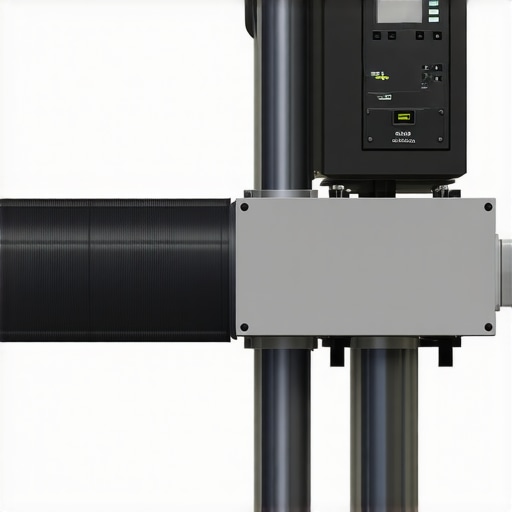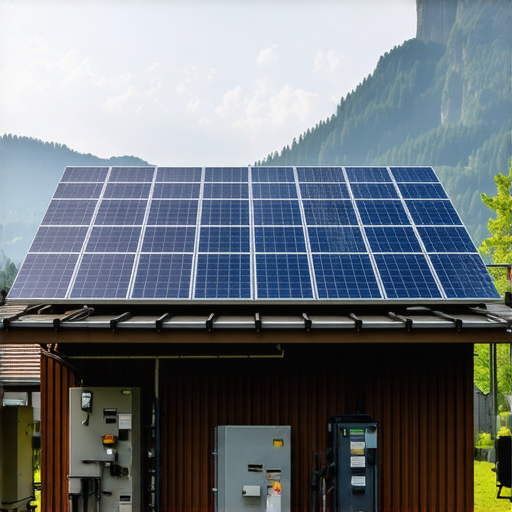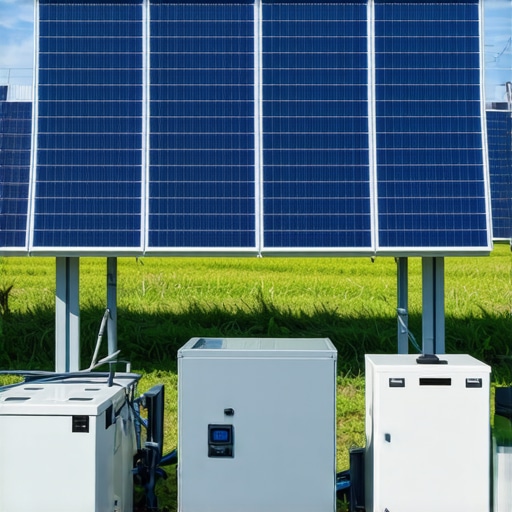Discovering Off-Grid Solar Power: A Personal Tale
As someone who always loved the idea of independence and sustainable living, I vividly remember the day I decided to embrace off-grid solar energy. Living in a remote area meant unreliable grid electricity, and I knew that investing in a reliable solar power system was my best shot at energy freedom. My journey began with a simple question: how do I ensure my solar inverter and battery bank are set up for maximum efficiency?
Building the Foundation: Why Solar Inverters Are My Power Hub
After hours of research and a few trial-and-error experiments, I realized that the solar inverter is the heart of any off-grid solar setup. It converts the DC power generated by my panels into AC power usable in my home. I learned that choosing the right inverter involves understanding wattage, surge capacity, and efficiency. I opted for a hybrid inverter, which allows me to connect both solar panels and a backup generator, providing peace of mind during cloudy days or emergencies. To deepen my understanding, I visited this resource on optimizing inverter performance.
My Experience with Battery Banks: The Key to Energy Storage
Battery banks are where I store excess energy produced during sunny days. Setting up my battery bank was like creating my own energy reservoir — I wanted enough capacity to power my home overnight and during cloudy weather. I chose lithium-ion batteries for their longevity and efficiency, despite the higher initial cost. Properly sizing my battery bank was crucial; I learned that it should match my daily energy consumption plus some buffer. This process involved careful calculations and consulting authoritative guides, which made me more confident in my setup.
What Surprised Me About Off-Grid Solar Systems
One thing I didn’t anticipate was how much attention the solar inverter’s placement and ventilation require. Overheating can significantly reduce efficiency and lifespan. I also discovered that regular maintenance, like checking connections and updating firmware, keeps everything running smoothly. These insights came from my own hands-on experience and reputable sources like future trends, which emphasize ongoing system improvements.
How Can I Optimize My Solar Inverter and Battery Bank for Longevity?
To ensure my system’s longevity, I focus on proper sizing, quality components, and regular maintenance. Installing a monitoring system helps me keep track of performance and identify issues early. I also educate myself through trusted resources, which is essential for adapting to new technologies and best practices. If you’re considering an off-grid solar setup, I recommend exploring comprehensive guides like this detailed manual.
If you’ve had your own off-grid solar experience or are just starting out, I’d love to hear your stories or questions. Feel free to comment below or reach out through contact us.
Ensuring Your Off-Grid Solar System Stands the Test of Time
One of the most critical aspects of maintaining a reliable off-grid solar setup is understanding how to optimize the longevity of your solar inverter and battery bank. As an enthusiast with hands-on experience, I can attest that proactive maintenance and strategic system design are paramount. Proper component selection, optimal placement, and ongoing monitoring can significantly extend the lifespan of your equipment, saving you both time and money in the long run.
Choosing High-Quality Components for Long-Term Reliability
When selecting inverters and batteries, prioritize reputable brands with proven track records. Investing in high-quality, durable components might have higher upfront costs, but it pays off through enhanced performance and durability. For example, lithium-ion batteries, despite being pricier initially, offer superior cycle life and stability compared to lead-acid options. Similarly, inverter models with robust thermal management features tend to resist overheating, which is a common cause of early failure. For comprehensive guidance on component selection, check out this resource.
Strategic Placement and Ventilation: Why It Matters
Proper placement of your inverter cannot be overstated. Installing it in a cool, well-ventilated area prevents overheating and ensures consistent operation. I learned this through trial and error; my initial setup suffered from frequent shutdowns due to heat buildup. Using a dedicated enclosure with adequate ventilation dramatically improved performance. Additionally, elevating your batteries and inverter off the ground can prevent moisture damage and facilitate airflow. For more on system setup best practices, visit this guide.

Implementing Routine Maintenance and Monitoring
Regular inspection is essential to catch potential issues before they escalate. Checking connections for corrosion, ensuring vents are unobstructed, and updating firmware are simple yet effective steps. Installing a monitoring system provides real-time data on system performance, allowing for early detection of anomalies. This proactive approach minimizes unexpected downtimes and prolongs component life. Trusted sources emphasize that consistent upkeep is the backbone of a resilient solar setup, as highlighted in future trends.
How Can I Balance Cost and Durability When Upgrading My Off-Grid System?
Striking the right balance involves evaluating your energy needs, budget, and the environmental conditions of your location. Opting for slightly higher initial investments in quality components can lead to substantial savings over time, as fewer replacements and repairs are needed. Moreover, integrating smart monitoring tools helps optimize usage and detect issues early, extending the service life of your system. For detailed strategies on system upgrades, explore this comprehensive manual.
If you’re passionate about refining your off-grid solar system or have insights to share, I invite you to comment below or reach out via our contact page. Sharing experiences can help us all build more resilient and efficient energy solutions.
Refining My Off-Grid Solar System: Lessons Learned from Deep Experience
Over the years, my journey with off-grid solar has evolved from basic setup to a nuanced understanding of system optimization. One realization I’ve come to appreciate is that even the most robust components can falter if not integrated thoughtfully. For instance, I learned that pairing a high-quality inverter with a smart, adaptive charge controller significantly enhances overall system resilience, especially in variable weather conditions. This insight was reinforced by consulting this comprehensive guide, which emphasizes the importance of system harmony over mere component quality.
What Are the Hidden Nuances in Battery Management for Longevity?
Battery management often gets simplified to just capacity and charge cycles, but the real key lies in understanding the subtle behaviors of batteries under different loads. I found that maintaining a consistent State of Charge (SoC) above 20% and below 80% can drastically prolong lithium-ion battery lifespan. Additionally, integrating a Battery Management System (BMS) that monitors temperature, voltage, and current allows for real-time adjustments, preventing premature aging. According to recent studies from industry leaders, these practices are critical for maximizing battery cycle life and performance.
How Can I Address the Complexity of System Monitoring and Data Analysis?
One of the most rewarding yet challenging aspects of my setup has been implementing comprehensive monitoring. Beyond simple readouts, I now utilize advanced data analytics to predict potential failures before they happen. Installing a monitoring platform that aggregates data from inverter, batteries, and solar panels has provided invaluable insights into system health. I regularly review performance trends, which helps me fine-tune the system—like adjusting charge settings during seasonal changes. This proactive approach aligns with expert recommendations found in this detailed manual, emphasizing continuous learning and adaptation.

Implementing advanced monitoring systems can seem daunting but pays off through early issue detection and performance optimization. Visualize a sleek dashboard displaying real-time metrics, alerting you to anomalies automatically.
Balancing Cost and Durability: My Personal Strategy
In my experience, the dilemma of balancing initial investment with long-term reliability is real. I’ve found that investing in premium batteries and inverter models with better thermal management reduces maintenance costs and downtime. For example, opting for lithium-iron phosphate batteries has proven more cost-effective over time, despite higher upfront costs, because of their superior thermal stability and longer cycle life. Meanwhile, smart system design, such as strategic component placement and proper ventilation, complements these choices. To explore this further, I recommend reviewing this resource, which offers insights into selecting sustainable, high-quality components tailored to your environment.
If you’ve been refining your own off-grid solar setup or are considering starting, I encourage you to share your experiences or ask questions in the comments. Learning from each other’s journeys helps us all build more durable and efficient systems.
The Crucial Role of Adaptive System Design in Off-Grid Longevity
Over years of managing off-grid solar installations, I’ve come to recognize that adaptability isn’t just a luxury—it’s a necessity. Incorporating modular components allows for seamless upgrades as technology evolves and energy needs shift. For example, integrating scalable battery systems with smart controllers enables me to expand capacity without overhauling the entire setup. This approach aligns with insights from industry experts, such as those detailed in this comprehensive guide, emphasizing future-proofing as a core principle.
Harnessing the Power of Data-Driven Maintenance
In my experience, sophisticated data analysis has transformed maintenance from reactive to proactive. Using advanced monitoring platforms, I can analyze performance trends over months and anticipate potential failures before they manifest physically. For instance, anomalies in voltage curves often precede inverter shutdowns, allowing me to perform targeted interventions. This predictive maintenance strategy not only reduces downtime but also extends component lifespan, corroborated by recent studies from industry research.
What Are the Critical Factors for Optimal Battery Management?
Battery longevity hinges on meticulous management of charge cycles, temperature, and voltage parameters. I’ve found that implementing a robust Battery Management System (BMS) that continuously monitors these variables is indispensable. Maintaining a State of Charge (SoC) between 20% and 80% minimizes stress on lithium-ion cells, significantly prolonging their useful life. Moreover, ensuring batteries are housed in thermally stable environments prevents overheating and capacity fade. For an in-depth exploration of best practices, I recommend reviewing this detailed manual.
How Can I Integrate Renewable Innovations to Enhance System Resilience?
Embracing emerging technologies like hybrid inverters with MPPT (Maximum Power Point Tracking) and smart energy management algorithms has been transformative. These innovations optimize energy harvest and storage, especially in variable weather conditions. Additionally, integrating supplementary renewable sources, such as small wind turbines or hydro generators, can diversify energy inputs and buffer against solar intermittency. According to recent technological forecasts, such hybrid systems will be central to resilient off-grid solutions in the coming decade.
What Expertise Is Needed to Tailor a High-Performance Off-Grid System?
Designing and maintaining a high-performance off-grid solar system demands a blend of electrical engineering knowledge, environmental understanding, and practical experience. From accurately assessing load requirements to selecting compatible components and implementing smart controls, each step benefits from specialized expertise. If you’re looking to elevate your setup, I encourage you to delve into this resource for advanced guidance. I also welcome you to share your own insights or questions—engaging with a community of experienced enthusiasts can accelerate your learning curve and lead to more resilient systems.
Things I Wish I Knew Earlier (or You Might Find Surprising)
1. The Hidden Power of Proper Placement
Initially, I underestimated how crucial the placement of my inverter was. Once I moved it to a cooler, well-ventilated spot, I noticed a significant boost in efficiency and lifespan. It’s a simple change that made a big difference in my system’s reliability.
2. Regular Maintenance Is a Game Changer
I used to think once everything was set up, I could forget about it. But consistent checks of connections, vents, and firmware updates have prevented many potential issues, saving me time and money in the long run.
3. The Balance Between Cost and Durability
Choosing the cheapest components often leads to more repairs. Investing in quality batteries and inverters, especially those with good thermal management, has paid off with fewer replacements and better performance over years.
4. Monitoring Transforms System Management
Installing a monitoring system was a revelation. Seeing real-time data helped me optimize energy use and catch problems early, making my off-grid setup much more resilient.
5. Flexibility and Future-Proofing Matter
Designing my system to be expandable allowed me to adapt as my energy needs grew. Modular batteries and scalable controllers gave me peace of mind that I can upgrade without starting from scratch.
6. The Subtle Nuances of Battery Management
I learned that maintaining a State of Charge between 20% and 80%, along with a good Battery Management System, can drastically extend battery life. It’s a nuanced process but well worth the effort.
Resources I’ve Come to Trust Over Time
- Off Grid Solar Resources: This website offers comprehensive guides and insights into system design and maintenance, which I found invaluable for in-depth understanding.
- Industry Leaders’ Reports: Industry research from reputable sources keeps me updated on emerging technologies and best practices, especially regarding battery innovations.
- Technical Manuals and Guides: Manuals like the one from the Ultimate Off-Grid Solar Kit Guide have been my go-to for detailed component selection and system setup procedures.
Parting Thoughts from My Perspective
Building and maintaining an off-grid solar system has been a journey of continuous learning and adaptation. From understanding the importance of proper component placement to trusting in high-quality parts and monitoring, every step has contributed to creating a resilient, long-lasting setup. If you’re passionate about sustainable living and want your off-grid system to stand the test of time, focus on proper design, regular maintenance, and staying informed through trusted resources. I genuinely believe that with patience and knowledge, anyone can achieve energy independence. If this resonated with you, I’d love to hear your thoughts or experiences—feel free to share below or reach out through our contact page.

